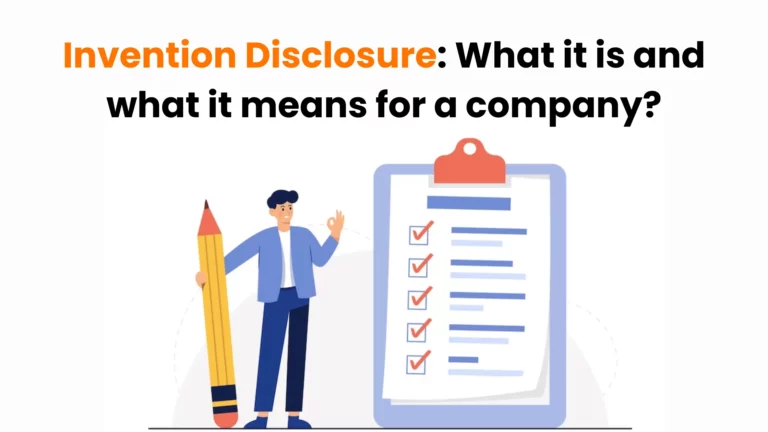That invention disclosure is the foundation of a strong patent application would be an understatement.
Let’s quickly talk about the difference between an invention disclosure and a patent before we move forward.
An invention disclosure is an inventor’s first notification to their company or organization that they have an invention worth protecting. The form establishes their ownership and includes the invention’s technical specifications, design, functionality, and details of co-inventor contributions.
On the other hand, a patent is a legal document issued by the USPTO that grants exclusive rights to the inventor. It prevents others from making, using, or selling the invention for a limited period without the inventor’s permission.
They are not the same! We’ll learn about the disclosures more in detail through this blog. Read on.
Related Read: The CIO’s Role in Innovation: 2023 Edition
So what is an invention disclosure form?
An invention disclosure form contains the most important aspects of a new invention by an inventor. They use it to notify their company, colleagues, and everyone out there about their discovery.
Often considered as the first step towards getting a patent, it is a technical yet concise document for disclosing a new invention.
Basically, a strong invention disclosure helps one get done with 90% of the patent application work.
Experts say it can cut down the patent application drafting process to a month or two from months or even a year.
And since the disclosure form sticks forever and makes your case in front of the examiner, it needs to be perfect.
What exactly does it contain?
- Who is the inventor? What is their contact information?
- What is the invention and its detailed description?
- What is the inventor trying to improve?
- What is the difference between the new idea and the existing solutions?
- What technical effect will the invention have?
- What makes the invention unique?
- Is there any prior art?
- What are the significant dates?
- Funding sources
- Signatures of inventors, co-inventors, and witnesses.
- And other technical aspects that InspireIP takes care of.
Related Read: Business Innovation: The What, Why, How, and Where
What is the invention disclosure form of a company?
Say an employee comes up with a new idea during research and development. They submit their idea to the idea management system of their company, and an internal attorney of the company finds that, in fact, it is an invention.
This is where the initial phase of getting a patent begins—disclosing the invention.
The company uses an innovation management software to collect inventions across its workforce and business divisions. It enables inventors to disclose their inventions through these standard forms curated through best practices in the automated system.
Related Read: A Complete Guide to Idea Management Software
Once inventors submit their forms, the company’s internal attorneys, review committee, and drafting attorneys come into play for the detailed evaluation and review process.
After it is complete, companies send the internal disclosure form to an external attorney, who starts the drafting and filing stage for the USPTO.
A detailed form enables the drafting attorneys to:
- understand the novelty of the invention
- verify the invention is non-obvious
- check if it fulfills the requirements of patentability
- evaluate the commercial potential of the innovation
- analyze the ability to protect it through patents, copyrights, or intellectual property
- check the co-inventors details and contributions
- check the third-party or open-source software or coding used if any
- review all the technical details and diagrams included in the form thoroughly
After a patent is filed, that application goes to USPTO for examination, and the examiner checks for:
- Its holistic novelty
- Whether or not it has new aspects
- Whether it should be pursued and allowed or not
- Whether the inventor is focusing on getting a patent for the right aspect
Invention disclosures help companies to keep track of the inventions developed by their employees. They are a great way to manage intellectual property rights and guarantee security and validity to the inventors.
Related Read: How to build an innovation strategy?
Why do employees need to submit an invention disclosure?
Most technology-driven companies are adopting an invention disclosure mechanism so employees can share their inventions effortlessly. It enables them to:
- Capture innovation.
- Receive patents, copyrights, and intellectual property rights.
- Provide swift recognition and acknowledgment.
- Legally establish the date of the original conception.
- Legally protect ideas with a well-written invention disclosure.
- Include all the features because missing an important feature can directly compromise the patent claim.
- Initiate the patent application process.
- Expedite the patent filing process.
- Encourage inventors to submit inventions.
In a Nutshell
Invention disclosure gets you started on the path to securing patent rights for your novel ideas that turned into inventions.
Every company must have professional software that takes care of the entire mechanism, starting from idea conception, drafting the invention disclosure, evaluating and collaborating on them to looping in external attorneys and inventors, filing it, and managing drafted patent applications.



